51 UMMA Objects
51 UMMA Objects
![<p>This type of bowl was extensively produced throughout the 12th century. The outer wall is decorated with incised and raised deisgn of a two-tiered lotus petal. The glaze was oxidized, producing yellow-green color, but the application of glaze to the entire foot and the use of quartzite spurs indicate that this was produced as a high-quality item.<br />
[<em>Korean Collection, University of Michigan Museum of Art</em> (2014) p.103]</p>
It has a wall gently curving from the mouth toward the bottom before angeling in sharply close to the foot. There is a lotus petal on exterior. The color is brown. <p>This type of bowl was extensively produced throughout the 12th century. The outer wall is decorated with incised and raised deisgn of a two-tiered lotus petal. The glaze was oxidized, producing yellow-green color, but the application of glaze to the entire foot and the use of quartzite spurs indicate that this was produced as a high-quality item.<br />
[<em>Korean Collection, University of Michigan Museum of Art</em> (2014) p.103]</p>
It has a wall gently curving from the mouth toward the bottom before angeling in sharply close to the foot. There is a lotus petal on exterior. The color is brown.](/media/W1siZiIsIjIwMjIvMDUvMjUvMTBnN25oa2prcF9kZWZhdWx0LmpwZyJdLFsicCIsInRodW1iIiwiMjQweDIwMCJdXQ?sha=225012457d334d64)
Korean (Korean (culture or style))
Bowl with carved lotus pattern
12th century
Transfer from the College of Architecture and Design
1972/2.78

Chinese (Chinese (culture or style))
Bowl
1000 – 1132
Gift of Mrs. Caroline I. Plumer for the James Marshall Plumer Collection
1973/2.14
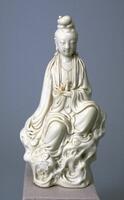
Chinese (Chinese (culture or style))
The Bodhisattva Guanyin
19th century
Gift of Willard A. and Marybelle Bouchard Hanna
1991/2.23
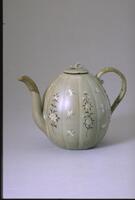
Korean (Korean (culture or style))
Ewer in the shape of a melon with inlaid floral and butterfly designs
1100 – 1150
Gift of Mrs. Caroline I. Plumer for the James Marshall Plumer Collection
1973/2.33
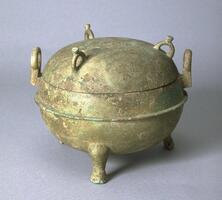
Chinese (Chinese (culture or style))
Ding (tripod vessel) with cover, in a squat spherical shape
9794 BCE – 220 CE
Museum purchase for the James Marshall Plumer Memorial Collection
1964/2.88
![<p>This bowl has a narrow foot and a ared mouth. is type of bowl was produced in large quantities from the 11th century to the 12th century. Its inner wall has mold-impressed peony sprays. The entire body of the bowl is glazed, including the inside of the foot, but the glaze on its rim of the foot was wiped away, on which refractory spurs were adhered to for ring. Parts of the inner surface show ne crackles, while the inner bottom was stained with greenish-brown iron spots. One part of the rim was damaged and subsequently repaired. Glaze applied to the outer surface has partially owed downwards, resulting in an uneven surface, but the glaze and clay are quite well fused and sintered.<br />
[<em>Korean Collection, University of Michigan Museum of Art</em> (2014) p.93]</p>
<br />
The celadon bowl has straight-lined sides. The surface is evenly coated with a dark bluish green glaze. The celadon bowl rests on a rather tall foot, which was hollowed out from the bottom. The designs are present only on the inside <p>This bowl has a narrow foot and a ared mouth. is type of bowl was produced in large quantities from the 11th century to the 12th century. Its inner wall has mold-impressed peony sprays. The entire body of the bowl is glazed, including the inside of the foot, but the glaze on its rim of the foot was wiped away, on which refractory spurs were adhered to for ring. Parts of the inner surface show ne crackles, while the inner bottom was stained with greenish-brown iron spots. One part of the rim was damaged and subsequently repaired. Glaze applied to the outer surface has partially owed downwards, resulting in an uneven surface, but the glaze and clay are quite well fused and sintered.<br />
[<em>Korean Collection, University of Michigan Museum of Art</em> (2014) p.93]</p>
<br />
The celadon bowl has straight-lined sides. The surface is evenly coated with a dark bluish green glaze. The celadon bowl rests on a rather tall foot, which was hollowed out from the bottom. The designs are present only on the inside](/media/W1siZiIsIjIwMjIvMDkvMjQvOWpqdXU4d2plel9kZWZhdWx0LmpwZyJdLFsicCIsInRodW1iIiwiMjQweDIwMCJdXQ?sha=d6b4e1202cb44ca4)
Korean (Korean (culture or style))
Conical bowl with molded floral design
12th century
Gift of Bruce and Inta Hasenkamp and Museum purchase made possible by Elder and Mrs. Sang-Yong Nam
2004/1.222
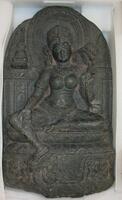
Indian (Indian (South Asian))
Tara
10th century
Gift of Dr. and Mrs. Leo S. Figiel and Dr. and Mrs. Steven J. Figiel
1981/2.156
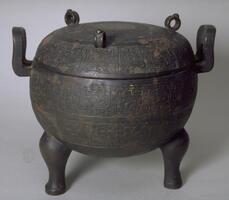
Chinese (Chinese (culture or style))
Ding (tripod vessel) and lid, with interlace design
9229 BCE
Transfer from the College of Architecture and Design
1972/2.98A&B
![<p>The cup has a mouth that curves slightly inwards; this is a form typical of round cups with saucers produced in large numbers in the 13th and 14th centuries. The cup is decorated only on the outer rim with a fret-patterned band. Repaired damage is visible on several parts on the mouth, as well as cracking that occurred during ring. Glaze has been applied down to the foot, and three quartzite spur marks remain on the outer base. The partially oxidized body displays darker patches on the surface, but it preserves a bright celadon color overall.<br />
[<em>Korean Collection, University of Michigan Museum of Art </em>(2014) p.120]</p>
The celadon cup has a mildly inverted rim with curved sides that are bent once, at a sharp angle, near the base. The surface is coated with a greenish blue glaze. The slightly inward-turning mouth facilitates drinking while the sides curve gently toward the base. <p>The cup has a mouth that curves slightly inwards; this is a form typical of round cups with saucers produced in large numbers in the 13th and 14th centuries. The cup is decorated only on the outer rim with a fret-patterned band. Repaired damage is visible on several parts on the mouth, as well as cracking that occurred during ring. Glaze has been applied down to the foot, and three quartzite spur marks remain on the outer base. The partially oxidized body displays darker patches on the surface, but it preserves a bright celadon color overall.<br />
[<em>Korean Collection, University of Michigan Museum of Art </em>(2014) p.120]</p>
The celadon cup has a mildly inverted rim with curved sides that are bent once, at a sharp angle, near the base. The surface is coated with a greenish blue glaze. The slightly inward-turning mouth facilitates drinking while the sides curve gently toward the base.](/media/W1siZiIsIjIwMjIvMDkvMjQvMmRjZTRvbXNlel9kZWZhdWx0LmpwZyJdLFsicCIsInRodW1iIiwiMjQweDIwMCJdXQ?sha=b6f3e998b597b135)
Korean (Korean (culture or style))
Wine cup with incised patterns
1100 – 1299
Gift of Bruce and Inta Hasenkamp and Museum purchase made possible by Elder and Mrs. Sang-Yong Nam
2004/1.225
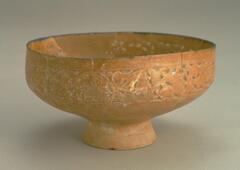
Iranian (Iranian)
Footed Bowl with openwork floral scroll design
1167 – 1232
Museum Purchase
1957/1.61
Loading…


